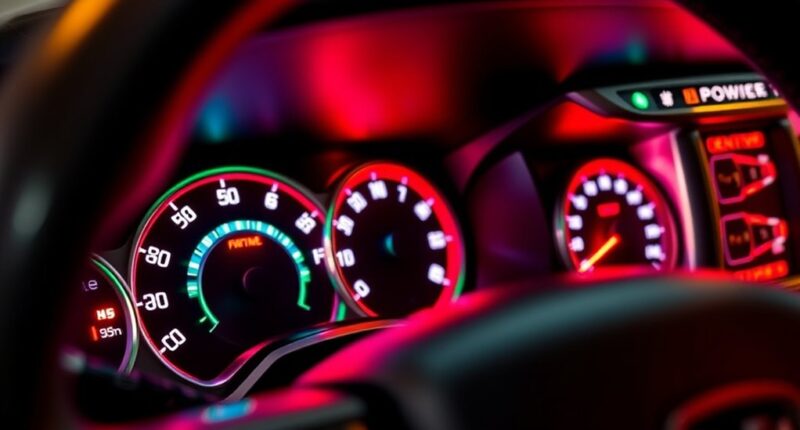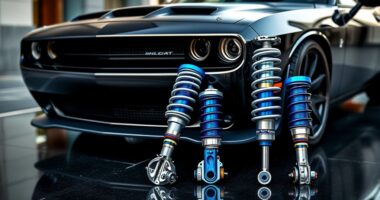To install a shift light in your Dodge Ram 1500, first verify compatibility and gather the necessary tools and materials. You’ll need to locate the RPM signal wire, usually from the ECM or ignition coil, and connect the wiring securely, following proper electrical procedures. Mount the light where it’s visible without causing distraction, then calibrate and test to ensure accurate performance. If you keep exploring, you’ll find detailed steps to optimize your system and troubleshoot issues effectively.
Key Takeaways
- Verify vehicle compatibility and locate RPM signal wire using wiring diagrams or OBD-II data for Dodge Ram 1500 models.
- Choose a suitable shift light unit, mount it securely on the dashboard or near the driver’s line of sight.
- Properly wire the shift light to the RPM signal, ignition power, and ground, ensuring secure connections and insulation.
- Calibrate the shift light’s RPM trigger settings to match your engine’s performance and desired shift points.
- Regularly inspect wiring and mounting stability, and update system software for reliable and precise operation.
Vehicle Compatibility and Preparation
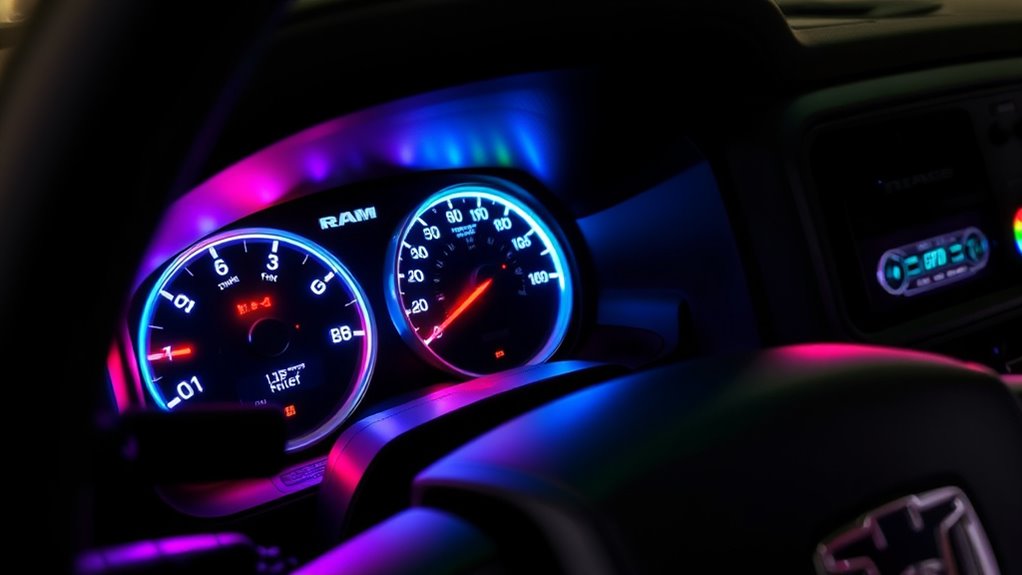
Before installing a shift light on your Dodge Ram 1500, it’s essential to verify that your vehicle is compatible and properly prepared. The Ram 1500 from 1994 to 2025 generally works with aftermarket tachometers and shift lights, but some models, like the 2021+ TRX, need specific wiring due to unique configurations. Factory shift lights are available on select trims, such as the 2023 Level 2 TRX, but may require activation through settings. Manual transmissions support factory upshift indicators, while automatic models typically don’t. Be aware of cluster variations across generations; older models may have bulb-based indicators. Confirm the presence of an RPM signal wire using wiring diagrams or OBD-II data. For modern models, using the OBD-II port is preferred over splicing factory wiring. Proper preparation ensures a smooth installation process, and understanding the vehicle compatibility plays a crucial role in ensuring successful installation.
Essential Tools and Materials Gathering
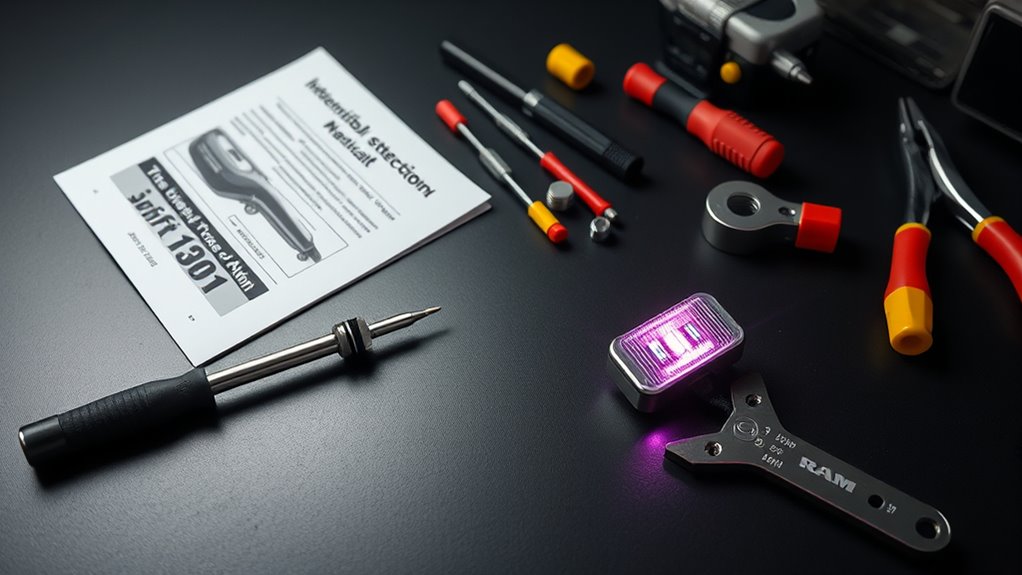
Gathering the right tools and materials is a crucial first step to guarantee a smooth shift light installation on your Dodge Ram 1500. You’ll need essential tools like a drill press for precise hole drilling, a socket set to remove dashboard components, wire strippers for electrical work, wire connectors for secure connections, and a screwdriver set for various screws. The necessary materials include the shift light unit, mounting brackets, wiring harness, electrical tape, and optional adhesive mounts. Safety items such as work lights, gloves, safety glasses, non-slip tools, and a first aid kit should also be on hand. Make certain your workspace is clean, well-lit, and stable. Having reference materials, assistance, and proper documentation ready will streamline the process and help prevent mistakes during installation. Additionally, understanding crypto market trends can be beneficial if you plan to explore digital assets related to vehicle modifications or community groups. Ensuring you have the right technical knowledge can greatly facilitate troubleshooting and installation success. As you prepare, consider reviewing sound healing science principles to enhance your focus and reduce stress during the project. Incorporating proper planning can help anticipate potential challenges and improve overall efficiency. Moreover, consulting essential oils for specific health concerns may provide comfort and stress relief during your work sessions.
Step-by-Step Wiring and Electrical Connections
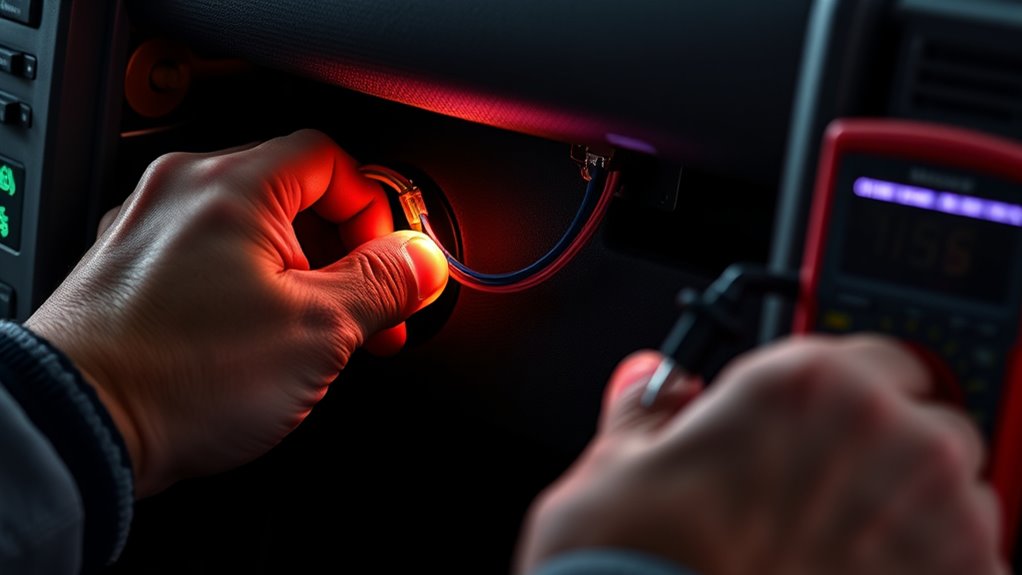
Once you’ve collected your tools and materials, the next step is to focus on wiring and making electrical connections for your shift light. Refer to your vehicle’s wiring diagram to identify the correct wires, especially the RPM signal source, which often comes from the ECM or ignition coil. Use the wiring codes to match colors and circuit functions accurately. Guarantee proper grounding by connecting the ground wire to a clean, solid chassis point, following safety precautions like wearing safety glasses. When soldering, use quality tools, and insulate connections to prevent shorts. Connect the power wire to a switched ignition source, ensuring it receives consistent voltage. Double-check all connections for security and correctness, avoiding loose or reversed wires that could cause malfunction or damage. Understanding the electrical connections involved can help prevent common issues and ensure reliable operation. Incorporating a water-resistant fuse into your wiring setup can further protect your system from electrical faults and moisture exposure. Proper circuit protection is essential for a safe and durable installation, especially considering the electrical systems in your vehicle.
Proper Mounting and Placement of the Shift Light
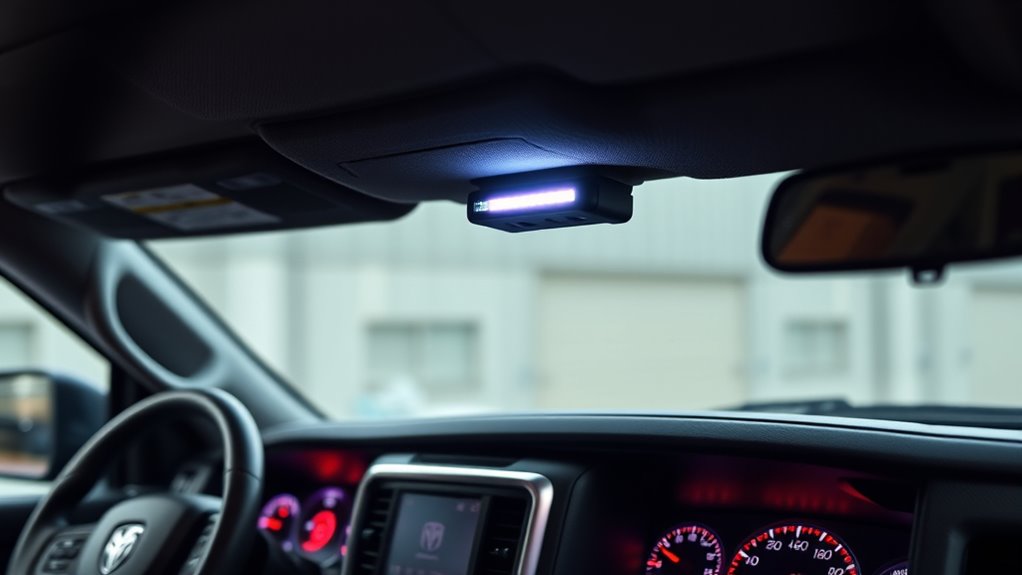
Choosing the right mounting location for your shift light is essential to guarantee it’s easily visible without distracting you while driving. Position it on the dashboard or near your line of sight so you can glance at it effortlessly. Ensure it’s clearly visible without obstructing your view of the road or essential dashboard instruments. The mount should be stable, preventing movement or vibrations that could impair performance. Also, select a location that complements your vehicle’s interior design, maintaining a cohesive look. Accessibility is key—place it where you can easily install, adjust, or remove it if needed. Keep in mind your personal preference to enhance usability, and choose a spot that minimizes distraction while supporting safe, efficient driving. Proper mounting stability is crucial to prevent distracting vibrations or shifts during driving. Additionally, considering ergonomic placement can improve overall usability and safety. Proper placement can also help in reducing driver fatigue, making your modifications more effective and enjoyable. Remember that a well-placed shift light can also contribute to the overall driver experience, making your modifications more effective and enjoyable.
Testing, Calibration, and Adjustment Procedures
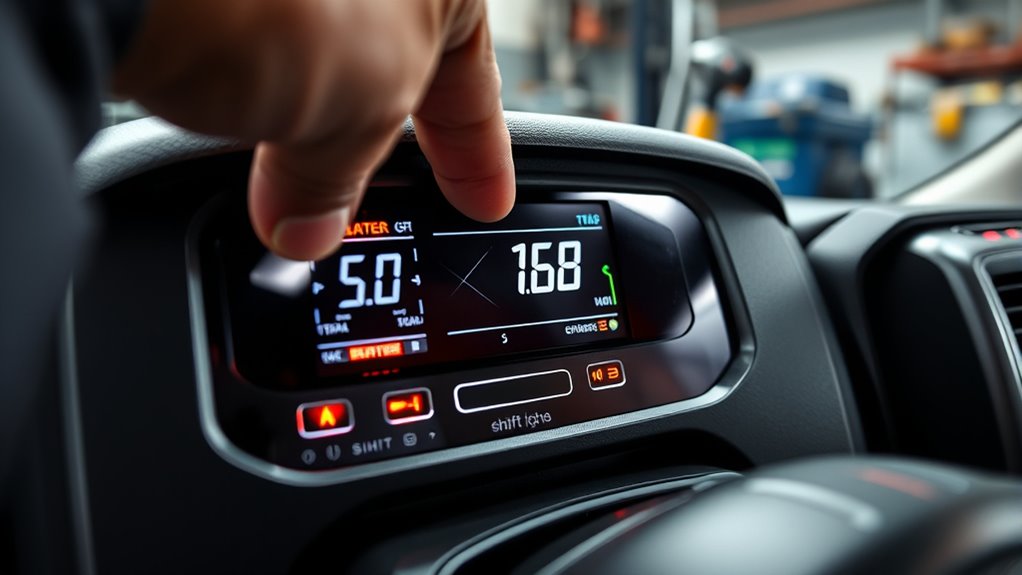
To guarantee your shift light functions correctly and accurately, you need to perform thorough testing, calibration, and adjustment procedures. Start by testing the instrument cluster during an actuator test to confirm the shift indicator and check wiring for damage or shorts. Use a DRB III scan tool to diagnose the PCM, CCD data bus, or message inputs. If the bulb isn’t lighting, replace it with a known good unit. Check for diagnostic trouble codes related to the shift light or transmission. Next, calibrate sensors like speed or throttle position sensors, reset transmission adaptation values, and perform adaptation resets if necessary. Adjust the trigger point based on RPM or load, modify brightness for visibility, and ensure wiring is secure. Regular calibration and adjustment keep your shift light functioning at its best. Incorporating sensor calibration practices can further enhance accuracy and performance, especially when considering the importance of color accuracy in vehicle displays and indicators. Additionally, verifying proper diagnostic procedures ensures that all system components are functioning correctly and helps prevent future issues. Understanding vehicle system diagnostics can improve troubleshooting efficiency and reduce downtime. Moreover, performing routine system checks can help identify potential issues before they affect your shift light’s operation.
Common Troubleshooting Tips and Maintenance
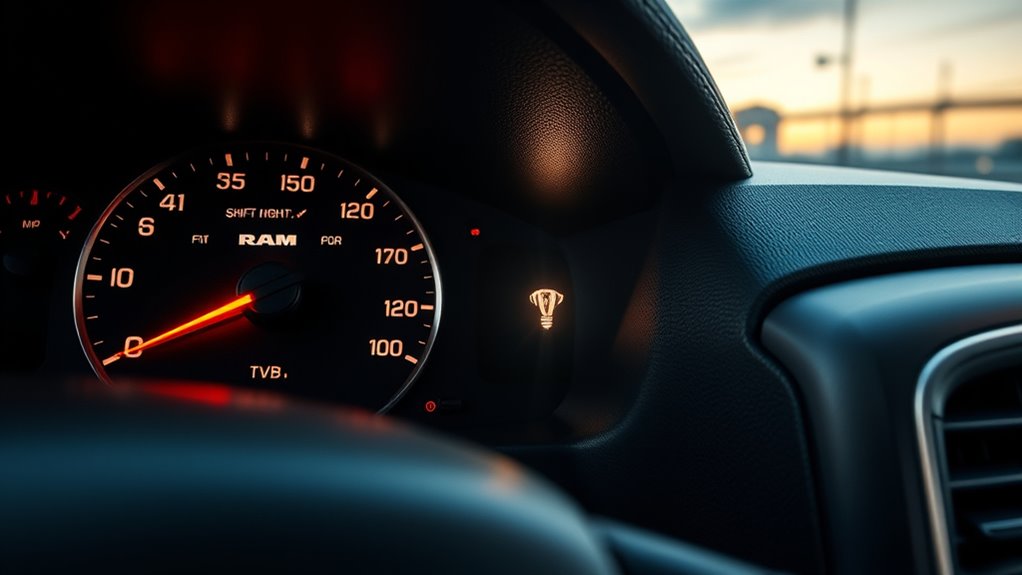
When troubleshooting shift light issues on your Dodge Ram 1500, start by thoroughly inspecting the wiring and connections. Look for loose, damaged, or corroded wires, and verify all connections are secure. Check the bulb or LED in the shift light system; replace any that are faulty. If the light flickers or works intermittently, examine relays and the instrument cluster for faults or software glitches. Confirm that components like the shift indicator switch are properly installed and functioning correctly. Regularly clean electrical connectors to prevent corrosion and guarantee good contact. Use diagnostic tools if needed to identify electrical faults. Keep the system’s software up to date and replace worn parts promptly. Proper maintenance and careful inspection help prevent recurring issues and ensure reliable shift light operation. Additionally, understanding the electrical system of your vehicle can aid in more accurate diagnosis and troubleshooting, especially as AI advances continue to influence automotive diagnostics and smart repair techniques. Staying informed about AI security developments can also help protect your vehicle’s electronic systems from potential vulnerabilities. Incorporating knowledge of lifestyle trends can also assist in planning maintenance routines that fit your schedule and driving habits. Regularly consulting vehicle manuals can further enhance your troubleshooting skills and ensure you follow manufacturer guidelines.
Upgrading and Enhancing Your Shift Light System
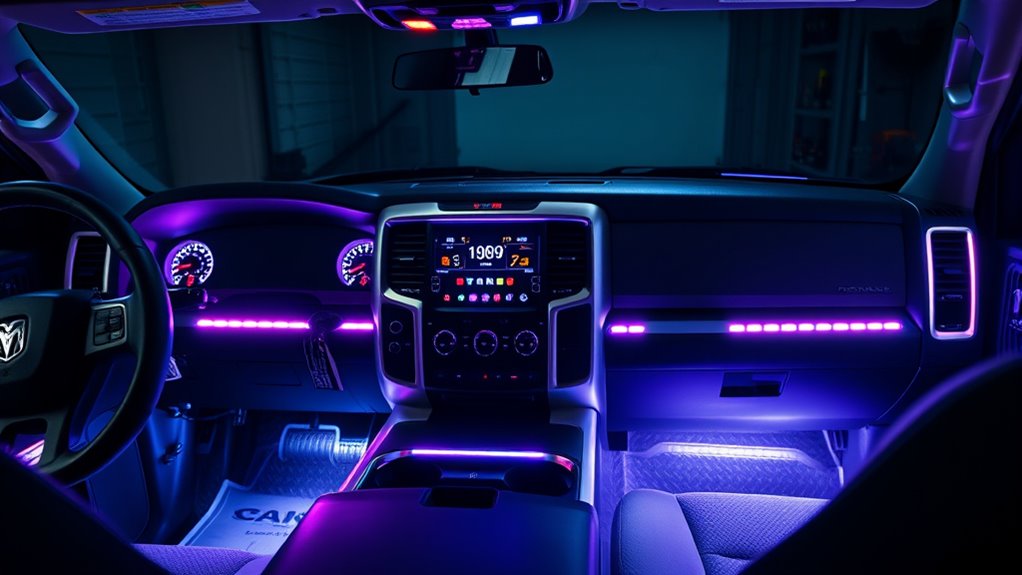
Upgrading your shift light system can substantially improve your Dodge Ram 1500’s performance and visibility. With options like the LED Digital Tachometer and Shift Light, you can customize and enhance your driving experience. These systems are compatible with 4, 6, and 8-cylinder engines, making them versatile for various models. Built with durable materials and bright LEDs, they withstand high-performance conditions. Installation is straightforward, usually involving a simple triple wire connection and minimal tools. Plus, a 1-year warranty offers peace of mind. To boost your setup further, consider external lighting kits for better visibility, color customization for style, or plug-and-play options for easier installation. Fine-tuning RPM settings helps optimize shifting, improving engine efficiency and performance overall.
Frequently Asked Questions
Can I Install a Shift Light on a Dodge Ram 1500 With Manual Transmission?
You can install a shift light on a Dodge Ram 1500 with a manual transmission, but it depends on your model. Manual transmissions make it easier because the shift light can be wired directly to monitor RPMs. However, if your Ram has an automatic transmission, you’ll need an aftermarket controller and some technical skill to adapt the system. Make sure to calibrate it for accurate shifting guidance.
Are There Wireless or Bluetooth Shift Light Options Compatible With the Ram 1500?
Imagine you’re in the year 2024, yet still searching for a wireless shift light for your Ram 1500. You can find Bluetooth-enabled kits like Oracle’s ColorSHIFT, which let you customize colors and brightness via an app. Universal remote kits also work, offering easy installation without firewall wiring. While no specific shift light exists for Rams, adaptable LED systems and third-party relays let you create a custom, wireless setup.
How Do I Program or Set Different RPM Thresholds for Multiple Shift Lights?
You want to program different RPM thresholds for multiple shift lights. First, access the shift light control system or software interface, which may be built into your device or vehicle. Then, select each shift light’s settings and input your desired RPM values. Save the configurations, and test the system by revving your engine. Adjust thresholds as needed for peak performance and tailored shift alerts.
Will Installing a Shift Light Affect My Vehicle’S Warranty or Electrical System?
Did you know nearly 30% of vehicle owners install aftermarket upgrades? Installing a shift light might impact your warranty if it’s not OEM-approved or causes system issues, so check your warranty policy first. It can also affect your electrical system if wired improperly or overloaded. To avoid problems, use proper wiring diagrams, protective measures, and consider professional help. This way, you enjoy the benefits without risking your vehicle’s reliability.
What Are the Best Practices for Hiding or Concealing the Wiring?
When hiding or concealing wiring, you should route wires through existing channels and behind panels to keep them out of sight. Use cable ties to secure wires neatly, and protect exposed sections with wire loom or heat shrink tubing. Avoid high-heat areas and moving parts. Tucking wires under trim panels maintains a clean look, while careful routing prevents interference or damage, ensuring a professional, unobtrusive installation.
Conclusion
Installing a shift light on your Dodge Ram 1500 is like giving your truck a sixth sense—alerting you precisely when to shift. With the right preparation, tools, and steps, you can easily upgrade your driving experience. Stay patient during testing and calibration, and don’t be afraid to troubleshoot issues. Once done, your truck will be tuned to perform at its best, turning every drive into a smooth, confident voyage.
